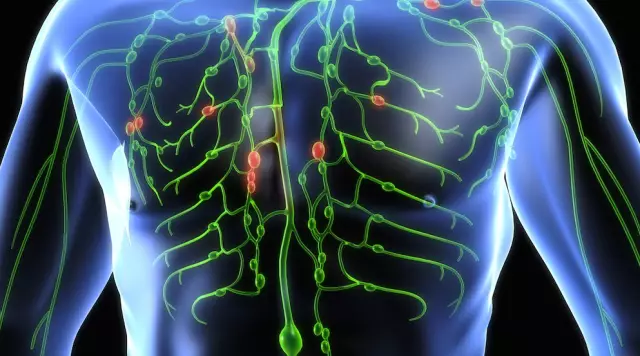- Author Rachel Wainwright [email protected].
- Public 2023-12-15 07:39.
- Last modified 2025-11-02 20:14.
Lymphatic system

The lymphatic system is the part of the vascular system that successfully adds the venous system and takes part in the metabolism.
An important function of the lymphatic system is the removal of foreign bodies from the circulatory system, as well as the cleansing of tissues and cells. From the tissues of the organs, the fluid first enters the lymphatic system, where it is filtered with the help of the lymph nodes, and after that, the lymph through the large vessels enters the thoracic lymphatic duct, where it flows from the chest into a large vein.
The lymphatic system consists of:
- Capillaries that form networks in all organs and tissues and are designed to remove fluid;
- Vessels formed from capillary connections. Vessels have valves, thanks to which the lymph moves in only one direction;
- Nodes that interrupt the vessels and dividing them into vessels entering and leaving the node. In the nodes, the lymph leaves all foreign bodies and microbes, and is also enriched with lymphocytes and through other vessels is sent to the chest lymphatic flow and the right lymphatic flow.
The functions of the lymphatic system can also include:
- Retention of toxins and bacteria;
- Return of electrolytes and proteins from tissues to blood;
- Removal of foreign bodies and erythrocytes;
- Lymphocyte and antibody production;
- Carrying over foods absorbed from food;
- Withdrawal of products through urine.
Organs of the lymphatic system:
- Bone marrow. All blood cells are created in it. Stem cells, created in the myeloid tissue of the bone marrow, enter the organs of the immune system.
- The spleen, which contains a large collection of lymph nodes. Dead blood cells disintegrate in it. It reacts sharply to foreign bodies and produces antibodies.
- Thymus. It accepts stem cells, converting them into T-lymphocytes (cells that destroy malignant cells and foreign bodies).
What does an increase in lymph nodes indicate?
Lymphadenopathy, or swollen lymph nodes, is fairly common. For a healthy person, the norm is a slight increase in the submandibular lymph nodes (no more than 1 cm), as well as an increase in the inguinal lymph nodes (no more than 2 cm).
If the increase exceeds the permissible limits, a biopsy and additional research may be required. Enlarged lymph nodes of the lymphatic system may indicate the following diseases:
- On the sides of the neck - sarcoidosis, mononucleosis, tuberculosis and vaccinations against it, as well as lymphoma and upper respiratory tract infections;
- In front and behind the auricles - rubella;
- Above the collarbone - tuberculosis, toxoplasmosis, stomach cancer (above the left collarbone);
- Under the lower jaw - gum problems or chronic tonsillitis;
- Under the arms - hand infections, breast cancer, sarcoidosis;
- On the bends of the elbows - sarcoidosis;
- In the groin - inflammation of the genitourinary system or the presence of a specific infection (herpes, syphilis), infections of the legs.
Swelling and inflammation of all groups of lymph nodes is an early symptom of HIV infection.
With lymphoma, the nodes become mobile and painless, and with metastases, they become welded and dense.
Diseases of the lymphatic system

Any disease does not pass without leaving a trace for all body systems. The lymphatic system reacts to disease primarily by enlarging the lymph nodes.
The main diseases of the lymphatic system are:
- Adenoids and chronic tonsillitis, when the tonsils cease to perform a protective function, becoming a source of infection. As a rule, with a prolonged infectious process, they are removed.
- Acute lymphadenitis is an inflammation of the lymph node caused by bacteria. The disease is accompanied by redness, soreness, and sometimes suppuration. The disease rarely occurs alone, more often it occurs as a result of inflammation of the area through which lymph flows.
- Chronic lymphadenitis. As a rule, this disease is a companion of other infectious diseases (syphilis, tuberculosis).
- Tumors of the lymphatic vessels. They can be both malignant (lymphangiosarcoma) and benign (lymphangioma).
Cleansing the lymphatic system
For the full functioning of the lymphatic system, it is necessary, at least, to move a lot. If a person leads a sedentary lifestyle, breathing exercises, exercises and long walks can help. It is important to know that movement cleanses the body and eliminates lymph congestion.
Cleansing of the lymphatic system is carried out through saliva, since the salivary glands are part of the general lymphatic system. The salivary glands draw out all dead cells and wastes from the body and take them out through the gastrointestinal tract.
The easiest way to cleanse your lymphatic system on a daily basis is to use ginger. To do this, after eating, you must dissolve, chew and swallow a piece of ginger. For the lymphatic system, this method is much more useful than a glass of water. Ginger irritates the mucous membranes and causes increased salivation.
The second way to cleanse the lymphatic system is juice. It is necessary to drink juice for several weeks, consisting of four parts of apple and carrot juice and one part of beet juice. It will be useful to add ginger root or ginger infusion to the juice.
Found a mistake in the text? Select it and press Ctrl + Enter.






